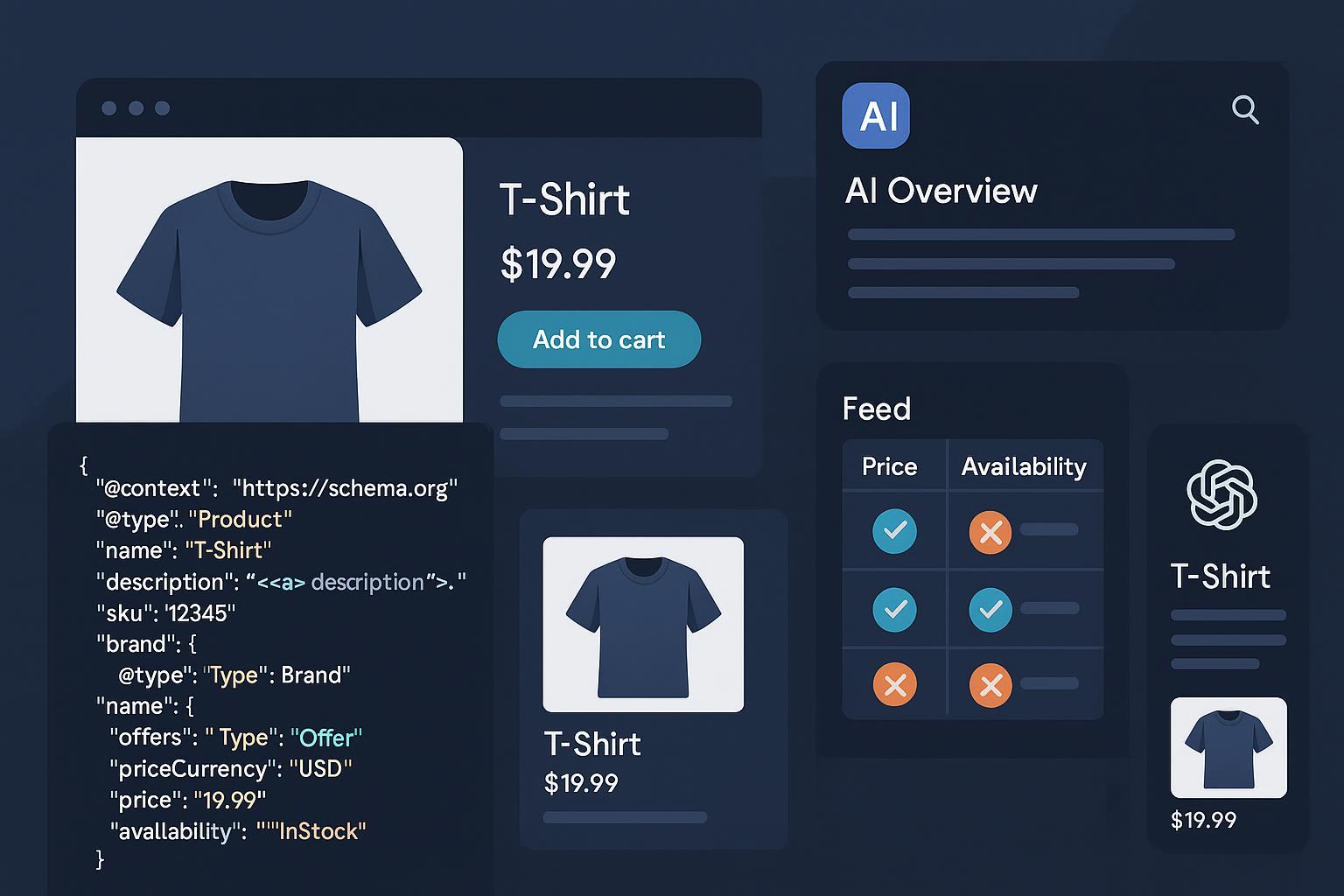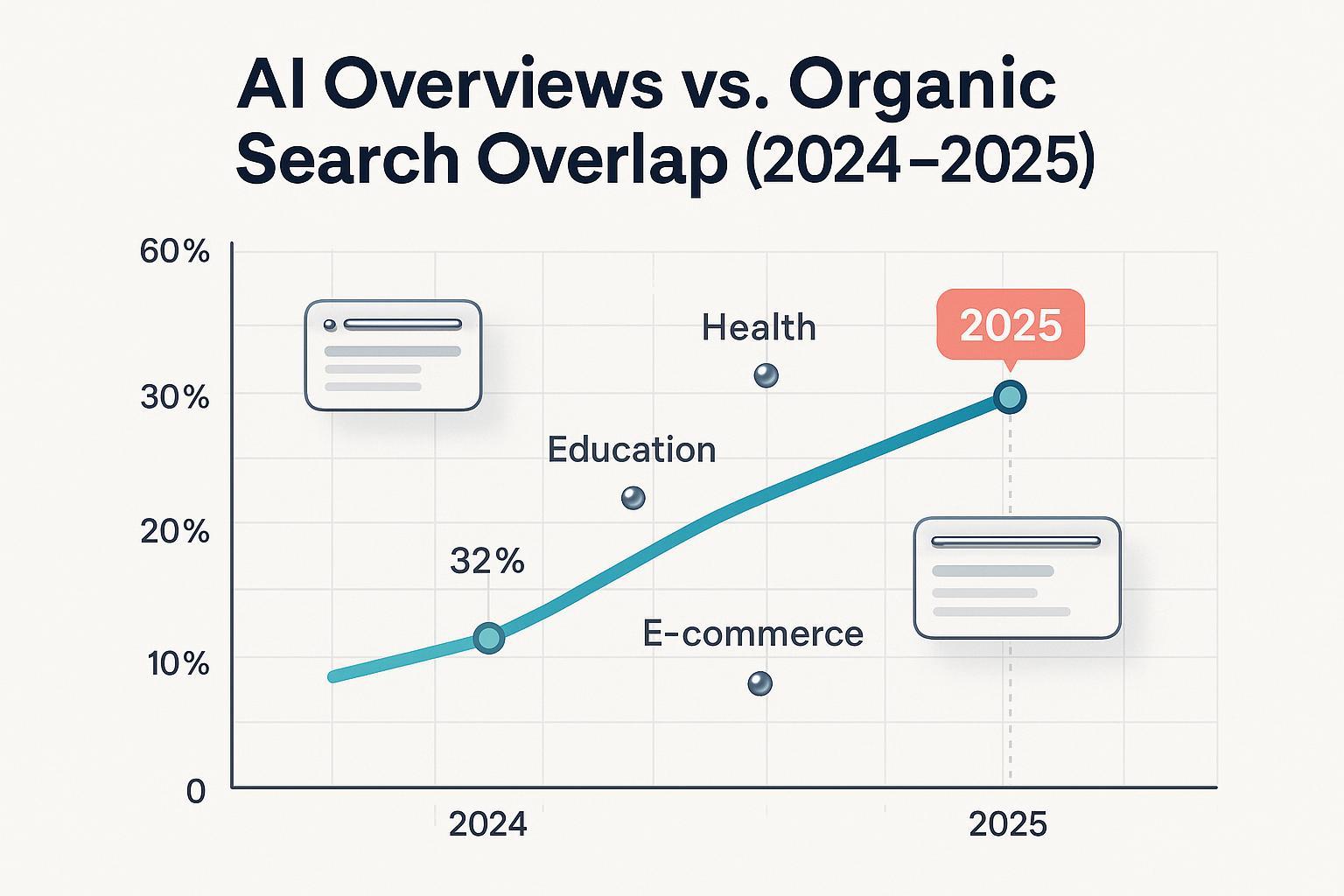How to Master Keyword Research in 2025
Master keyword research in 2025 with AI tools, long-tail strategies, and intent analysis to boost SEO, adapt to trends, and outperform your competition.

You can master keyword research in 2025 by thinking about what users want, the situation, and making good content. Now, search engines like keywords that answer real questions and needs. Zero-click SERPs and voice search have changed SEO a lot. You need a plan that uses long-tail keywords, talking phrases, and local SEO. AI-powered tools help you pick the best keywords by looking at search trends and how people act. You should watch how your keywords do and change your plan often to stay ahead in search.
Key Takeaways
Learn about your audience by using tools and surveys. Find out what they search for and what they need. Use AI-powered and regular keyword tools to find the best keywords. These tools also help you see new trends fast. Look at your competitors often to find keyword gaps. This helps you find new chances for your content. Focus on local SEO and voice search. Use natural and question-based phrases. Update your Google Business Profile often. Check how your keywords are doing often. Change your plan to stay ahead as search engines and trends change.
Set Goals
Audience Insights
You need to know your audience before you start any seo work. Start by looking at keyword data with tools like Google Trends or Demographics.io. These tools show you who searches for your topics, including their age, gender, and location. Next, check your website visitor data in Google Analytics. This helps you see who visits your site and what they like. You can also study your competitors with tools such as Quantcast or Audiense. These platforms give you more details about your audience and what they care about.
Social media can help you learn even more. Use Facebook Insights or Followerwonk to see what your followers talk about and what interests them. Sometimes, you should ask your audience directly. Create surveys to collect information about their needs and interests. You can also use tools like AlsoAsked or AnswerThePublic to find out what questions people ask online. This helps you understand search intent and find long-tail keywords for your seo strategy.
Tip: Build a simple table to track your audience’s age, location, and top interests. This makes it easier to spot trends and gaps in your seo approach.
SEO Objectives
You should set clear goals for your seo strategy. Many businesses in 2025 focus on increasing organic traffic from targeted keywords. Local seo is also important. Add location-based keywords to your content, page titles, and meta descriptions. Create local landing pages to reach people in your area.
Improve your internal linking structure. Use targeted anchor text to help users and search engines move through your site.
Grow your brand mentions and awareness. Try guest blogging or working with influencers to get your name out there.
Work on your conversion rates. Test different headlines and calls to action on your landing pages to see what works best.
Track your progress with seo tools and analytics. Set SMART goals so you can measure your results and adjust your strategy as needed.
Keyword Discovery

How to Do Keyword Research
You can master how to do keyword research by following a clear step-by-step process. Start by thinking about your audience and what they want to know. This helps you find the right keywords for your website or blog. Here is a simple way to begin:
Define your goals for keyword research. Decide if you want more visitors, more sales, or better local reach.
Learn about your audience. Use surveys, feedback, and social media to find out what they search for and what problems they face.
Brainstorm keyword ideas. Write down words and phrases related to your topic or business. Think about what people type into search engines.
Use keyword research tools like Google Keyword Planner, Ahrefs, and Ubersuggest. These tools help you find more keyword ideas, check search volume, and see how hard it is to rank.
Check the search intent. Make sure your keywords match what people want to find, such as information, products, or services.
Analyze your competitors. Look at their websites to find keyword gaps and new keyword ideas.
Organize your keywords. Group them by topic, search volume, and how easy they are to rank for.
Use your keywords in your content, meta tags, and URLs. Make sure they fit naturally.
Keep updating your keyword list. Trends change, so review your keywords often.
Tip: Always look for high traffic keywords, but do not ignore long-tail and low-competition keywords. These can bring steady visitors and are easier to rank for.
Many people ask how to find low competition keywords. You can do this by using filters in keyword research tools. Look for keywords with good search volume but low keyword difficulty scores. These keywords give you a better chance to appear on the first page of search results.
AI and Tools
AI-powered keyword research tools have changed how you find keyword ideas in 2025. These tools use machine learning and natural language processing to give you better keyword suggestions. They can save you time and help you find keywords that match user intent.
Tool/Aspect | Impact/Benefit | Example/Source |
|---|---|---|
Accuracy | Semrush study | |
Organic Traffic | AI tools can boost organic traffic by up to 20% | SEMrush |
Sales Revenue | AI analysis of user intent can increase sales revenue by 30% | Ahrefs report |
Market Share | AI-driven analysis can increase market share by up to 15% | SuperAGI study |
Search Rankings | 25% increase in search rankings with AI keyword optimization | Moz |
Research Time | 40% less time spent on keyword research | WordStream |
Content Engagement | 50% more engagement by analyzing user intent with AI | Content Marketing Institute |
Conversion Rates | 25% higher conversion rates using AI-powered keyword research tools | WordStream |
CPC Reduction | 30% lower cost-per-click (CPC) with AI keyword tools | WordStream |
Notable Tools | SuperAGI, Semrush, Ahrefs, BrightEdge, WordStream | Mentioned throughout document |
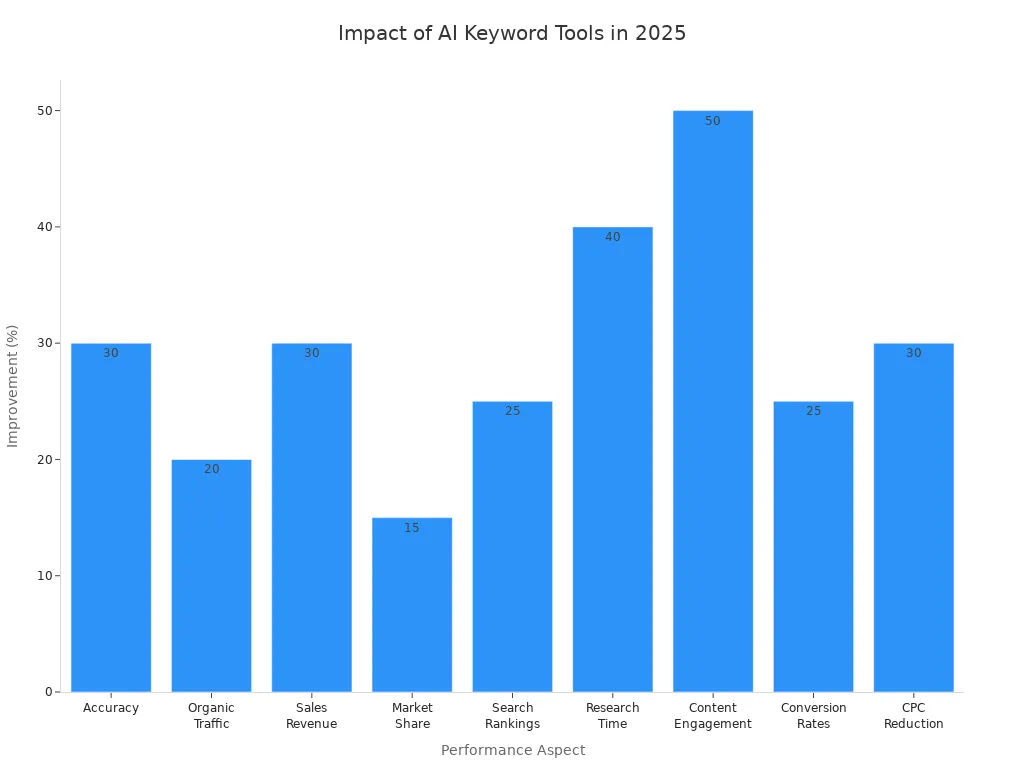
You can use tools like SuperAGI, Semrush, Ahrefs, and BrightEdge. These keyword research tools help you find keyword ideas, check search volume, and see trends. AI tools also help you spot trending keywords and long-tail keyword ideas that match what people are searching for right now. They can even group keywords by search intent, such as informational or transactional, so you can create the right content.
Note: AI tools can reduce your keyword research time by 40%. They also help you find keywords that lead to more conversions and better rankings.
When you compare keyword research tools, look at data accuracy and how easy they are to use. For example, Ahrefs gives you accurate search volume and keyword difficulty. Moz offers a simple interface and good keyword suggestions. SEMrush has detailed analytics and is easy to use. Each tool has strengths, so pick the one that fits your needs.
Google Trends & Suggest
Google Trends is a powerful tool for keyword research. It shows you what people are searching for right now and helps you spot new trends. You can use the "Trending Now" feature to find topics that are getting popular fast. This lets you create content before everyone else does.
Here are some ways to use Google Trends for keyword research:
Check "Trending Now" to find topics with fast-growing interest.
Look at related topics and queries to get new keyword ideas.
Find seasonality patterns. Plan your content calendar so you publish before peak search times.
Compare similar search terms to see which words people prefer.
Validate new keyword ideas with other keyword research tools. Check search volume and keyword difficulty.
Focus on keywords with commercial intent and manageable difficulty for better SEO results.
Use Google Trends to improve YouTube SEO by finding trending video topics.
You can also use Google Suggest. When you start typing in the Google search bar, it shows you popular searches. These suggestions give you more keyword ideas and show what people are looking for.
Tip: Combine Google Trends with tools like SEMrush or Ahrefs. This helps you check if your keyword ideas have enough search volume and are not too hard to rank for.
In 2025, trending keywords in many industries have high search volume and strong competition. For example, legal and SaaS keywords often have high CPC and conversion rates. Local service keywords like "emergency plumbing services" also bring good ROI. You should balance high-volume keywords with long-tail and local keywords to get the best results.
Remember: Search engines keep changing. You need to update your keyword research often. Watch for new trends and adjust your keyword ideas to stay ahead.
Competitor & Intent Analysis
Competitor Research
You can learn from your competitors by looking at their keyword plans. Use SEMrush, Ahrefs, or Google Keyword Planner to find their keywords. These tools show you what keywords your competitors rank for. Next, check things like search volume and keyword difficulty. This helps you see which keywords are most valuable.
Here are some steps for good competitor keyword research:
Find out which keywords your competitors use.
Look at keyword data to see their value.
Put similar keywords into groups with keyword clustering.
Spot market gaps and new chances by studying competitors.
Use advanced keyword tools to learn more about your audience.
AI-powered tools make this work faster and more exact. Machine learning can look at lots of competitor content quickly. This helps you find keyword gaps and new topics. AI keyword research can also help you get more conversions and better content.
Tip: Keep checking your competitors to stay up to date with search trends.
Search Intent
Knowing search intent is important for keyword research. You must know why people use certain keywords. This helps you make content that matches what users want.
To figure out search intent, do these steps:
Sort keywords by intent: informational, commercial, transactional, or navigational.
Look at the search results to see what content ranks high.
Check for paid ads and use Google Ads to spot commercial intent.
Notice words in searches, like questions or time words.
Use keyword tools that show intent data.
Watch user engagement, like bounce rate and time on page.
Add schema markup and fix URLs to show intent to search engines.
AI tools like ChatGPT or Google’s Gemini can help you understand search intent. These tools help you match your content to what users need and improve your keyword research.
Content Gaps
Finding content gaps helps you a lot in keyword research. Tools like Ahrefs' Content Gap and SEMrush's Keyword Gap let you compare your site to others. You can see which keywords your competitors rank for but you do not.
Here is how to use these tools:
Pick your website and up to five competitors.
Run a content gap check to get missing keywords.
Look at the report to find new keyword ideas.
Use these keywords in your content plan.
Ahrefs and SEMrush help you find topics and keywords you missed. This lets you fill gaps with strong content. By using these keywords, you can get better search rankings and reach more people.
Note: Keep updating your keyword research and content gap checks to stay ahead in search.
Prioritize & Apply
Best Keywords for SEO
You need to pick the best keywords for seo to get real results. Start by making a big list of keywords using tools like SEMrush or Google Keyword Planner. Cover all the topics that matter for your business or blog. Next, remove any topics that do not fit your goals or your audience’s needs. This step keeps your content strategy focused.
Ask yourself four questions for each keyword:
Is this keyword transactional? Does it show that someone wants to buy or take action?
Does it show up in Google’s autofill with at least 10 suggestions? This means people search for it often.
Can your website rank for this keyword within a year?
Do you already rank in the top three for this keyword?
You should focus on transactional keywords first. These bring visitors who are ready to act. Mark your most valuable keywords as “A” and the next best as “B.” Share your list with your team or client and get feedback. Update your list until it matches your business goals.
Use professional tools like Ahrefs and Semrush to check keyword difficulty and search volume. Look at your competitors. See if you can beat them for certain keywords. Pick keywords where you can build links and improve your ranking. This approach helps you build a strong content strategy that supports your business.
Tip: Transactional keywords often bring the highest return on investment. Always check if your site can rank for them before you spend time and resources.
Keyword Research for Bloggers
If you write a blog, keyword research for bloggers is key to growing your audience. Start by thinking about broad topics in your niche. Use keyword research tools to find more ideas and specific search terms. Mix different types of keywords in your content strategy:
Head terms: Short, popular keywords with lots of competition.
Long-tail keywords: Longer phrases with less competition. These work well for new blogs.
Question-based keywords: Phrases that answer what your readers ask.
Focus on what your readers want. Do not just chase high search volume. Make sure your keywords match your blog’s goals. Use headings with keywords, short paragraphs, lists, and images to make your posts easy to read. Place your main keyword in the title, URL, headings, and meta description. This helps search engines understand your post.
Promote your keyword-optimized blog post on social media. Build links from other sites to boost your authority. Track your results with Google Analytics and Search Console. See which posts get the most traffic and update old posts to keep them fresh. This ongoing process helps you grow your organic traffic.
You should also look at your competitors. Find out which keywords they use and where they get their traffic. Use keyword clustering to group related keywords. This makes your content strategy stronger and helps you cover more topics. Analyze the search results to see what works and adjust your plan.
Note: Regularly update your keyword research for bloggers. Trends change fast, and you want your blog to stay ahead.
Content Optimization
Content optimization means making your content strategy work better for both users and search engines. Start by building your content around 4-6 main topics, called content pillars. Each pillar should cover a big idea in your niche. Use keyword research to find high-value keywords for each pillar.
Match your page type to the search intent. For example, use informational keywords for guides and transactional keywords for product pages. Place your keywords in important spots:
Title tags
Meta descriptions
Headings
URLs
Image alt text
Body content
Use keyword clusters and content gap analysis to find new chances for your content strategy. Always track how your keywords perform. Update your posts to keep up with new trends. Make sure your site loads fast, works on mobile, and is easy to read. Good internal linking helps users and search engines move through your site.
Avoid common mistakes in keyword organization:
Do not skip keyword research. Use long-tail keywords to attract the right visitors.
Always check search intent. Make sure your content matches what users want.
Prevent keyword cannibalization. Give each keyword-optimized blog post a clear focus so your pages do not compete with each other.
Callout: AI tools help you spot new keyword opportunities and track performance. Use them to keep your content strategy up to date.
A strong content strategy uses the best keywords for seo, matches user intent, and adapts to new trends. You need to balance quick wins with long-term growth. Keep measuring your results and adjust your plan as needed. This way, your search engine optimization will stay effective and your keyword-optimized blog post will reach more people.
Local Keyword Research

Local SEO Tactics
You can help your business grow with local keyword research and local seo tactics. First, find out what words people in your area use to search for your services. Put these keywords on your website, in your blog posts, and in your photo alt text. This helps search engines show your business to people nearby.
Many small businesses get great results from local keyword research. For example, one business got 85 Google reviews, updated blog posts, and added keywords to photos. Their search ranking went from 81.7 to 4. The table below shows how each tactic helped:
Tactic | Description | Result |
|---|---|---|
Google Reviews | Got 85 customer reviews | Better search ranking and trust |
Blog Content Optimization | Updated and improved blog posts | More people saw the business online |
Keyword Optimization | Put keywords in photo alt text | Search performance got better |
Backlink Outreach | Asked other sites for backlinks | Domain authority went up |
Search Ranking Improvement | Used all tactics together | Ranking jumped from 81.7 to 4 |
You should also work on your Google Business Profile, build citations, and manage reviews. These local seo tactics help you show up in the Google Map Pack and get more calls and visits. Businesses that use local seo often see a 71% positive return on investment. Making your site work well on phones can bring 50% more local traffic. Searches for "open now near me" have grown by 400%.
Tip: Watch your rankings, traffic, and calls to track your progress. Most businesses see results in 3-6 months, and even more growth in 6-12 months.
Voice Search Trends
Voice search is changing local keyword research and local seo. More people use voice assistants to find local businesses. About 55-58% of voice searches are for local results. You need to use long-tail, natural phrases like "Where is the best pizza place near me?" in your content.
Voice search makes local keyword research even more important. Add question-based keywords and keep your Google Business Profile updated. Make sure your website loads fast and works well on phones. Use structured data like FAQ and How-To schema so search engines understand your content.
Aspect | Impact Description |
|---|---|
Conversational Keywords | Use long-tail, natural language, and question-based phrases |
Local SEO | 55-58% of voice searches are about local businesses |
Technical SEO | Fast page speed, mobile-first indexing, and structured data for voice search |
Content Strategy | FAQ-style content and speakable schema markup |
The chart below shows that local seo tactics like Google Business Profile, citation building, and content creation give high ROI for many businesses.
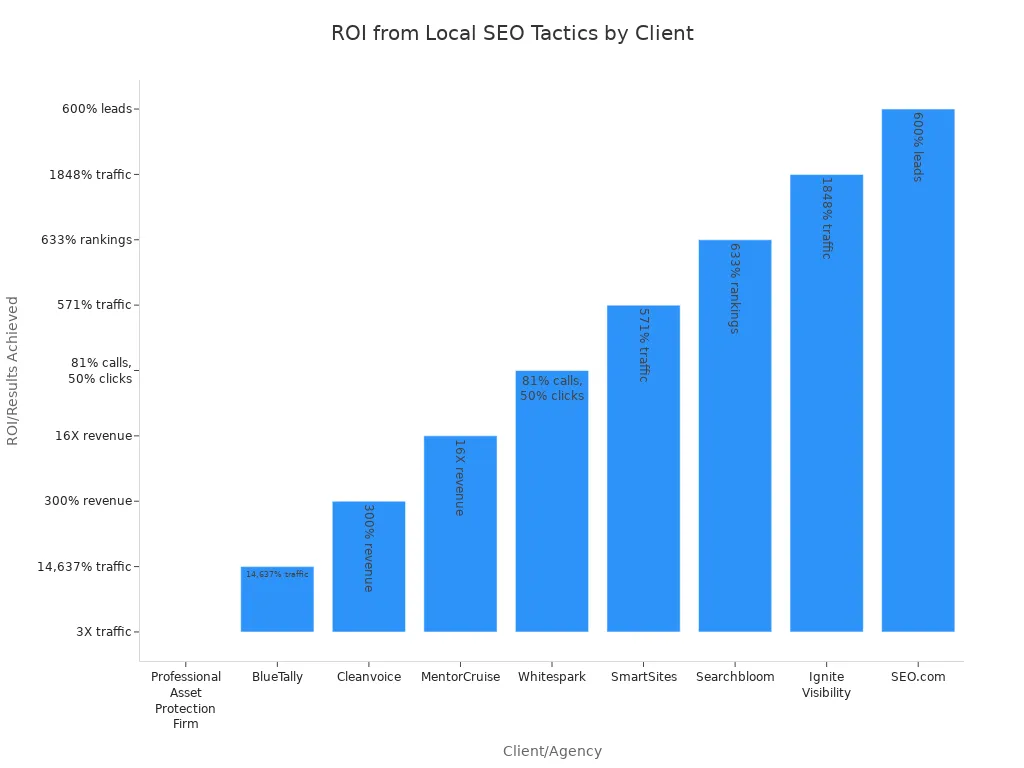
Note: As more people use voice search, you need to keep updating your local keyword research and local seo plan to stay ahead.
Track & Refine
Performance Metrics
You need to watch the right performance metrics to know if your keyword research is working. These metrics show how your website shows up in search and how people use your content. Here are some important metrics you should check:
Search volume tells you how many people search for a keyword each month.
Volume of mentions shows how often your keyword or brand is seen online.
Keyword difficulty tells you how hard it is to rank for a keyword.
Total reach is the number of people who see your keywords.
Search intent helps you learn why people search for certain words.
Mention intent shows the reason or feeling behind keyword mentions.
Sentiment tracks if people talk about you in a good, bad, or neutral way.
Share of voice compares how visible you are to your competitors.
Advertising Value Equivalent (AVE) shows what your mentions would cost as ads.
Organic traffic counts visitors who come from search without paid ads.
Conversion rate from organic traffic shows how many visitors take action, like signing up or buying something.
Keyword rankings let you see where your keywords show up in search results.
Click-through rate (CTR) tells you how many people click your site from search.
Bounce rate and dwell time show if people find your content useful.
Core Web Vitals measure how fast your page loads and if it works well on phones.
Backlink profile and referring domains track links from other websites.
Indexed pages and crawl errors help you check if search engines can find your content.
Tip: Use tools like Google Analytics, SEMrush, or Ahrefs to watch these metrics and make your organic search results better.
Update Strategy
You should update your keyword strategy often to keep your SEO strong. Google changes its search rules many times each year. You need to pay attention and change your keywords to match new trends and what users want. Most experts say you should check your keyword list at least every few months. For important or tough keywords, you may need to update even more often.
Keyword Type | Notes | |
|---|---|---|
High-intent, competitive | Every 6 months or more often | These change fast and need quick updates |
Broader 'Best' keywords | About every 400 days | Update with new reviews and comparisons |
'Rates' keywords | About every 496 days | Refresh with the latest numbers |
'What is' & 'How to' keywords | Less often, focus on checking | Make sure they are correct and easy to use |
High difficulty (KD 90+) | About every 320 days | Needs more updates to stay ahead |
Average for all content | About every 2 years | Shows how content gets old over time |
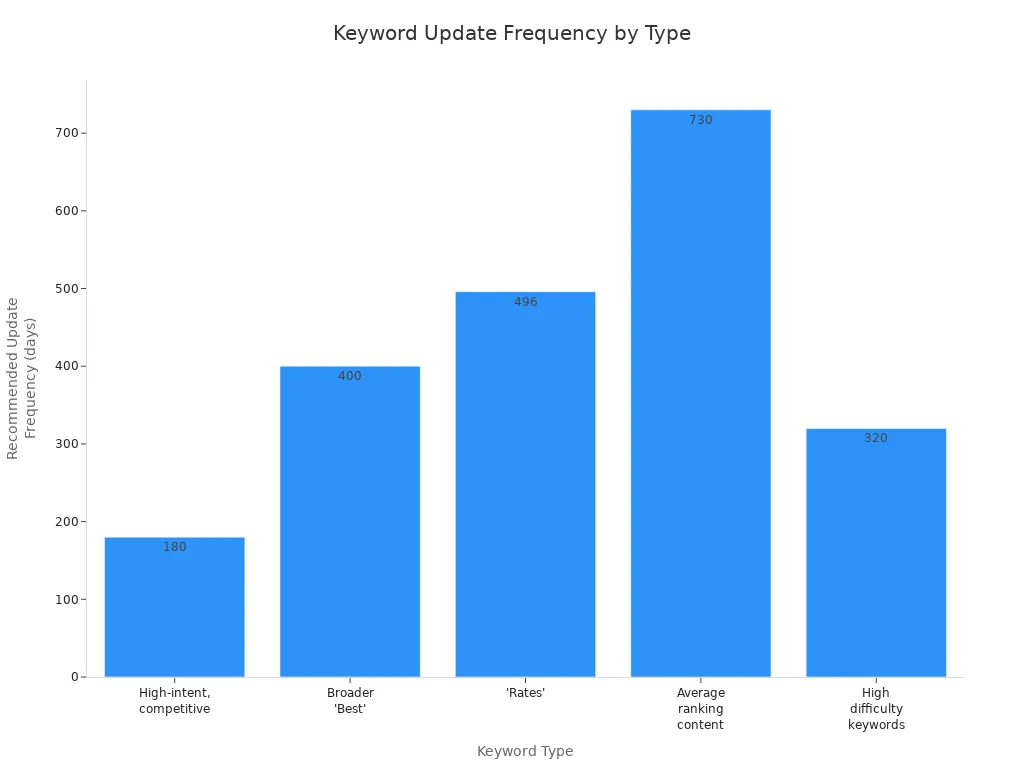
To make your keyword performance better, follow these steps:
Check your current content and keyword results with Google Analytics.
Look at search results and keyword phrases to see what people want.
Study your competitors to find missing topics and new keyword ideas.
Use "People Also Ask" and Google autofill to find more keyword ideas.
Change your keywords and content based on what works best.
You should see how well your work is doing by tracking organic traffic growth, keyword rankings, and conversion rates. Focus on keywords that help your business and update your plan as search trends change. This ongoing process helps you stay seen in search and grow your reach.
You can master keyword research in 2025 by following a few key steps:
1. Focus on what your customers want at each stage of their journey. 2. Use both AI-powered and traditional tools to find and analyze keywords. 3. Check your competitors often to spot new opportunities. 4. Track your SEO progress every month and update your strategy.
Stay adaptable because search engines change their rules often.
Make user intent, local SEO, and content quality your top priorities for long-term success.
FAQ
What is the best tool for keyword research in 2025?
You can use tools like Semrush, Ahrefs, or SuperAGI. These tools use AI to find strong keywords. They help you see trends and check how hard it is to rank for each keyword.
How often should you update your keyword list?
You should check your keyword list every few months. Trends change fast. Updating your list helps you stay ahead and keep your content fresh.
Why are long-tail keywords important?
Long-tail keywords bring visitors who want specific answers. You can rank for these keywords more easily. They often lead to higher conversion rates.
How does voice search affect keyword research?
Voice search uses natural, spoken phrases. You need to add question-based and conversational keywords. This helps your content show up in voice search results.
Can you use the same keywords for local and global SEO?
You should use different keywords for local and global SEO. Local SEO needs city or region names. Global SEO uses broader terms.
Tip: Mix both types if you want to reach local and worldwide users.
See Also
Effective Strategies To Excel At AI Search Optimization
Ranking Techniques For B2B Generative AI Search SEO
Top Five Sectors Benefiting From Generative Search Today
Understanding Long-Tail Keywords: SEO Advantages And AI Uses
Semantic Search Explained: Concepts And AI Optimization Insights

